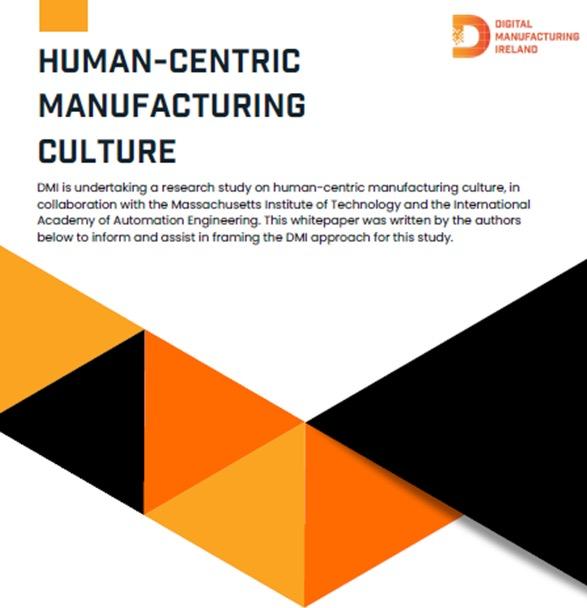Human-Centric Manufacturing Culture Study





 Domhnall Carroll CEO, Digital Manufacturing Ireland
Domhnall Carroll CEO, Digital Manufacturing Ireland






 Domhnall Carroll CEO, Digital Manufacturing Ireland
Domhnall Carroll CEO, Digital Manufacturing Ireland

“In today's fast-paced manufacturing landscape, organisations are inundated with technological change and opportunity. However, the successful integration of these technologies requires more than just implementation — it demands a deep understanding of how they intersect with the people driving the industry forward. By prioritising the human element, companies can harness the full potential of innovation while fostering a culture of collaboration and adaptability.
At DMI, we recognise that the journey towards human-centric manufacturing isn't just about implementing new processes; it's about cultivating a mindset that places equal emphasis on the technological and human aspects of production. Our approach centres on fostering a culture of continuous learning and innovation, where employees are empowered to not only embrace new technologies but also contribute their unique insights to drive organisational growth. Through our HCM initiatives, we aim to equip manufacturers with the tools and strategies needed to navigate the complexities of modern manufacturing while nurturing a workforce that thrives in the face of change.

Launched by the Irish Government in 2023, Digital Manufacturing Ireland’s mission as an industry-led organisation is to enable all Irish-based manufacturers to access, adopt and accelerate new digital technologies that solve real-world challenges and drive the Irish manufacturing sector’s future competitiveness.
Located in IDA’s National Technology Park in Limerick, DMI’s purpose-built facility offers an exemplary physical and virtual environment via a 12,000 sq. ft ‘Digital Factory’ for both MNE and SME manufacturers to develop and scale digitally enabled solutions to address industry challenges safely before deployment in a live environment.
DMI’s vision is to position the Irish discrete manufacturing base at the forefront of digital transformation and to ensure that Ireland is recognised internationally as having a vibrant, collaborative, competitive and digitally enabled industry base, ideally suited to delivering the next generation of manufacturing.
To help achieve this vision, DMI drives the establishment of collaboration groups that offer Centres of Excellence (CoE) across the manufacturing ecosystem. The goal of a CoE is to develop solutions to real-world manufacturing challenges through a uniquely collaborative process. The CoE makes use of the core expertise and infrastructure of DMI (project managers, industry-based subject matter experts, data scientists, collaboration facilitators and a range of digital assets) in addition to seconded resources from collaboration partners to form focused and resultsdriven industry collaboration groups.
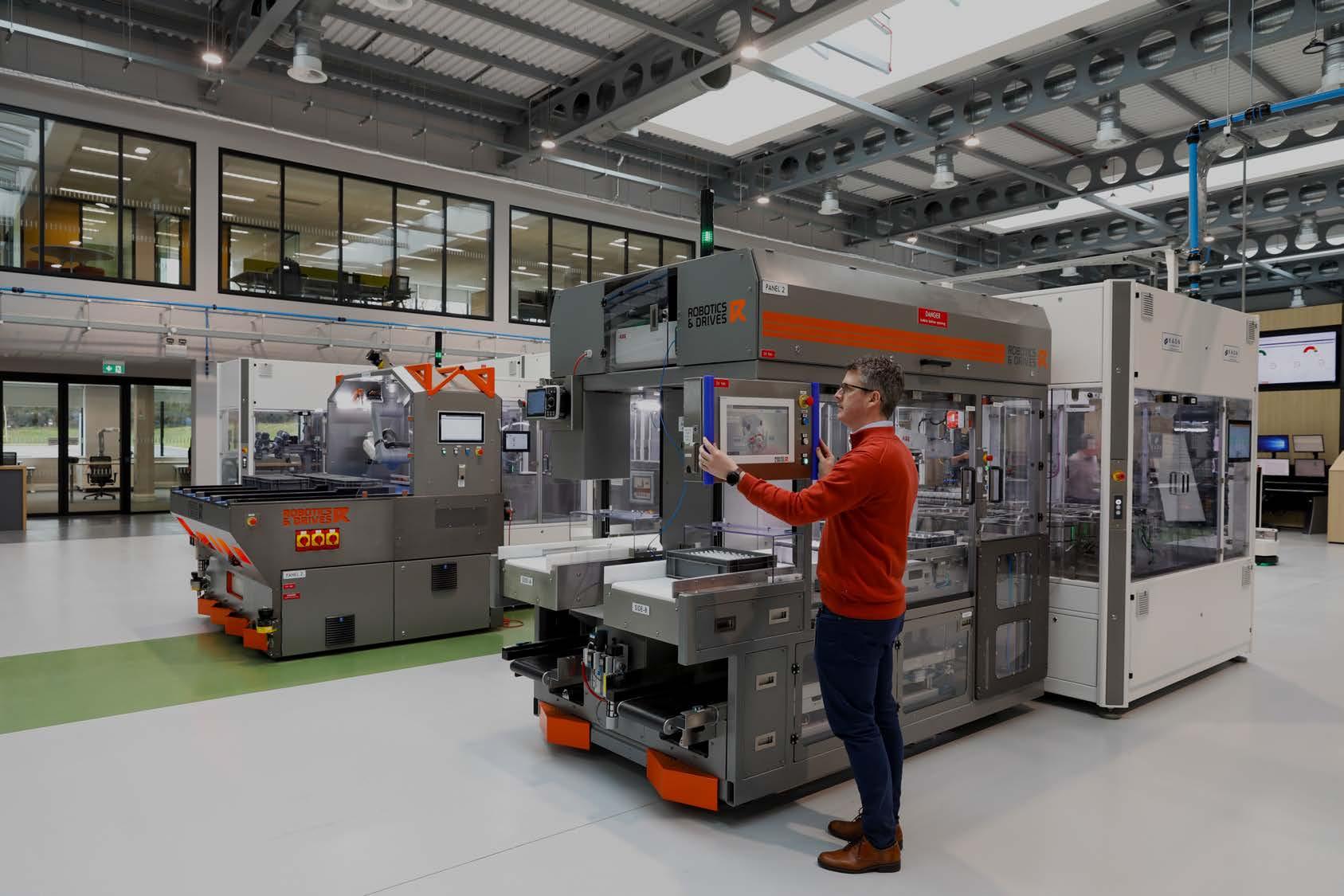


Digital Manufacturing Ireland (DMI) operates to primary pillars of technology adoption, data science, workforce transformation, and operations and supply chain optimisation.
It is this context that DMI has undertaken this research study on humancentric manufacturing culture (HCM), in partnership with the Sociotechnical Systems Research Center at the Massachusetts Institute of Technology (MIT) and the International Academy of Automation Engineering (IAAE).
The motivation is to gain insight and knowledge relating to HCM and HCM Culture, to inform positioning Ireland at the forefront of both research and practice for human-centric manufacturing and workforce transformation.
Eleven Medtech organisations with manufacturing operations in Ireland participated in this research study.
AbbVie,Alcon, Bausch & Lomb, Boston Scientific, Cook Medical,Edwards Lifesciences, J&J, Medtronic, Transitions Optical, VistaMed /Freudenberg Medical, and West Pharma
To cite this report: Copyright 2024 DMI, MIT, IAAE, Human-Centric Manufacturing Culture Study 2023

01 Executive Summary
02 Introduction
What is Human - Centric Manufacturing (HCM)?
What is HCM Culture and why is it important?
What motivates this research study?
Why should organisations invest in transforming to a HCM culture?
03 Contextualising this Research Study
What is Industry 5.0?
What is the Megatrend for Manufacturing?
What is the Irish policy context for this study?
04
Why the Medtech sector was chosen Research Project Roadmap Research Study Approach
05 Findings
Top Three Cited Challenges
Perceived Levels of Connection Points of Agreement Forces For and Against HCM Culture
06 Twelve Emergent Themes Imperatives Values Strategies Practices
07 Collaboration Opportunities
08 Conclusions and Recommendations
What new thinking is needed by leaders?
What should leaders do differently?
What about Ireland's culture gives a HCM advantage?
09 References and Appendices



The potential and necessity of digital technology and innovation are transforming the future of manufacturing and the future of work, and by consequence, relationships between humans and digital technology.
Human-centric manufacturing (HCM) leverages the power of digital technology, while fully engaging humans in decision making and operations where they are most needed and uniquely capable. It considers not just human-technology interactions but also the human-to-human interactions through technology. Achieving the promise of HCM necessitates having the workforce deeply engaged in the design and deployment of new technologies, including robotics and AI.
Additionally, the megatrend of manufacturing is that manufacturing production techniques have advanced from craft production in the 1850s, to mass production (c.1910), to mass customisation (1980s), to personalisation (2000s), and now mass personalisation (2010s). The three most recent innovations have occurred in less than a single human generation. It is for this reason that this study aims to elevate the importance of culture and its significance for individual wellbeing and organisational competitiveness.
Ireland is particularly well-positioned to pursue opportunities arising from the digitalisation of manufacturing and the Irish government has set out to "facilitate the current and future workforce to develop the skills to deliver transformation and exploit the new opportunities arising in manufacturing and supply chain firms through emerging technologies" (Ireland's Industry 4.0 Strategy 2020-2025). This HCM Culture study seeks to inform the positioning of Ireland at the forefront of both research and practice for human-centric manufacturing and workforce transformation.
This research study was designed to include multiple points of engagement with, and interim feedback to, industryleaders over a one-year period. The Irish MedTech sector was selected for this study given the changing nature of work within this vibrant sector. An industry focus group workshop was conducted in March 2023 to elicit insights of leaders on HCM culture challenges,context and opportunities, including participants from 9 companies and leaders from the Department of Enterprise, Trade & Employment, IDA Ireland, and IBEC. Further data was gathered using a survey that was completed by 89 leaders from 11 organisations inIreland. This was followed by in-depth site interviews with the leadership teams of 6 organisations represented by a total of 60 people. Using expert knowledge, aggregated survey data and interview findings, the research team synthesised the findings into 12 themes grouped by 4 categories. A panel session providedpreliminary validation of findings. An action-oriented workshopwas then held in November 2023 to share findings andgather additional research data from the 11 organisations. Further analysis and synthesis of results was conducted, and used to derive recommendations, identify collaboration actionareas, and define future work.
Based on this research, only one-third of the leaders agree/strongly agree their site is promoting the necessaryhuman-centric manufacturing culture changes for digital transformation. This appears to be due to a combination of ambiguity around what characterises human-centric manufacturing, lack of understanding that digital manufacturing requires a cultural transformation, and insufficient knowledge concerning how to realise a human-centric digital manufacturing culture.
Manufacturing leaders will have an important role in shaping the culture, strategies, and enablingenvironments that are necessary to achieve the benefits of humancentric manufacturing. This study is a first step toward grounding future programs and initiatives within a framework that can measure their impact over time. In the conclusion and recommendations section of this report some of the new thinkingthat is needed by manufacturing leaders along with recommendations as to what leaders can begin to do differently is detailed.




A visual guide showing engagement steps during 2023 for participating industry organisations
DMI initiated a research study in collaboration with two research partners, IAAE and MIT, in support of this important focus for future manufacturing.
The motivation is to gain insight and knowledge to inform positioning Ireland at the forefront of both research and practice for human-centric manufacturing and workforce transformation.
As shown in the roadmap, the research study was included multiple points of engagement with, and interim feedback to industry leaders over a one-year period.

January Project announcement
March
Industry focus groups
June Engagement overview virtual call
July-Aug Surveys
Sep-Nov
In-person interviews
November
Remote interviews
November Panel session to brief participating manufacturers
November Deployment workshop to illustrate research to action opportunities


Re-invigorate your leadership philosophy and practices with a whole-person view of work and workers, with appropriate inclusion in decision-making at strategic, tactical, and operational levels.
Carefully identify how to retain and strengthen the best of your existing culture, and how to use evidence-based approaches to do so.
Reflect more proactively on the cultural impact to your organisation that stems from digital manufacturing choices and bring a focus to creating organisational capacity forchange.
Consider how to be more empathetic of operation and technical staff's daily frustrations of legacy processes, both for physical and information flows.
Assess how to design intrinsic rewards that your organisation could offer to better leverage attracting or keeping talent.
Deepen your understanding of the opportunities, benefits, and crucially, potential unintended consequences of Industry 4.0 technologies and automation.
Renew your thinking as to how you are using the skills that already exist in your organisation, as well as the new skills and roles that need to be developed at every level.
Use digital technology/data to better empower self-directed teams and equip productgroup leads with suitable information at the right time.
Identify industry collaboration opportunities relating to human-centric manufacturing to both learn about and contribute to best practices.
Consider an internal forum for your leaders to have an opportunity for open discussion about HCM and tangible ways to include new thinking.
Elevate workforce well-beingas a key criteria for digital transformation investment.
Ensure multidisciplinary teams are involved in design and testing of digital dashboards that display leading indicators, motivate the right behaviours, and make problems visible early to facilitate fast problem solving.
Take steps to enhance your own understanding of systems thinking, organisational change management, design thinking, and human performance, - each will add a key dimension to your thinking as a leader.
Push tolerance for failure philosophy into the team level so it becomes included in team norms with an opportunity to innovatein sandbox environments.


What is Human-Centric Manufacturing (HCM)?
What is HCM Culture and why is it important?
What motivates this research study?
Why should organisations invest in transforming to a HCM culture?
Digital manufacturing enterprises have primarily taken a technology-centric focus for digital transformation. Yet, technology alone will not suffice if manufacturing enterprises are to fully realise the true promise of digital technology.
Placing sole focus on the digital technology and the technical advantages it offers, typically leads to a situation where people are forced to adapt to the technology without fully considering whether it enhances individual performance and workforce wellbeing.
Human-centric manufacturing leverages advanced digital technologies, while fully engaging humans in decision making and operations where they are most needed and uniquely capable.
To read more about how the research team framed the approach for this study, see this HCM Culture Whitepaper.
Human-centric manufacturing shifts the paradigm for the digital manufacturing enterprise to a predominantly human-centric focus in achieving its envisioned digital future.


Human-centric focus

Human-centric manufacturing is more than a new approach arising from digital transformation; it is a cultural transformation.
HCM culture gives primary emphasis to human wellbeing. Human needs and wellbeing are placed at the centre of manufacturing systems and processes, and technology is selected and adapted to serve the needs and diversity of the workforce, rather than having workers continuously adapting to ever-evolving technology.
"HCM brings a fresh perspective and one which can bring additional benefits."
"Every organisation is facing the same challenges, and it is all about collaboration."
"We need to understand HCM better, the science behind it, and examples of it working."
"We need open forum discussions on how people can better the environment they work in through use of digitalisation."
Why is this study important for manufacturing leaders in Ireland?
HCM culture transformation is more complex than the ongoing digital technology adoption
Leaders need to be informed on new thinking and new strategies for HCM culture transformation
This study provides new insights for HCM culture leadership that can be used to develop tools and supports
"I personally lack knowledge of what a world class HCM site that leveraged digital technology might look like."
"An initiative that shares knowledge from the experience of others is something I need to support a culture of human centric manufacturing."
Quotes from HCM Culture Workshop participants during March and November workshops 2023




"Only one third
of leaders agree or strongly agree that their site is promoting necessary human-centric manufacturing culturechanges for digital transformation, and 30% are either neutral or disagree.”

Inform
Inform the positioning of Ireland at the forefront of both research and practice for human-centric manufacturing and workforce transformation.
Understand
Understand the current state of digital manufacturing transformation in Irish manufacturing organisations, with a focus on the MedTech sector.
Gather insights
Gather insights into how manufacturers are leading and supporting their people in context of digital manufacturing.
Contribute
Contribute to future collaboration and research.












future digital manufacturing











manufacturing culture change, with its nuances of management, generational differences,




within a framework that can measure their impact over time.


Accelerate digital technology adoption and innovation

Effective upskilling and reskilling oforganisation's existing workforce

Enhance business results and competitiveness through a focus on bothpeople andperformance

Enable faster and better strategic, tactical, and operational decisions, by providing suitable information to the right person at the right time

Attract and retain the top performers in digital manufacturing

Gain value from harmonisation of human capabilities, digital technologies and operational strategies

Make impactful digital technology investment decisions through the lens of the wellbeing of the workforce


What is Industry 5.0?
What is the Megatrend for Manufacturing?
What is the Irish policy context for this study?


_promotes talents, diversity and empowerment
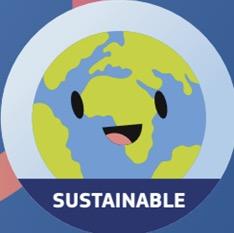
…is agile and resilient with flexible and adaptable technologies
…leads action on sustainability and respects planetary boundaries
Industry 5.0 Human-centric, sustainable and resilient
https://op.europa.eu/en/publication-detail/-/publication/aed3280d-70fe11eb-9ac9-01aa75ed71a1
Industry 5.0 is a term that was first introduced by the EU in 2020. It should not be understood as a chronological continuation of,nor analternative to, the existing Industry 4.0 paradigm.
It is the result of a forward-looking exercise to help frame how European industry and emerging societal trends and needs can co-exist.
Industry 5.0 has three key pillars. It emphasises resilience, sustainability, and human-centricity, that are understood to bedeciding factors, not just economic or technological, for the place of industryin the future of European society.
It shifts focus from techno-economic value to societal value, and from welfare of the worker tothe wellbeing of the worker.
European Commission, Directorate-General for Research and Innovation, Industry 5.0 – Human-centric, sustainable and resilient, Publications Office, 2020

It is helpful to visualise industry eras, and the related advances in manufacturing approaches and systems, with this diagram from a recent paper in the Journal of Manufacturing Systems.
Starting at the bottom right and following the curved line upwards, consider the transition from craft production through to mass personalisation and notice how a system-centric or technologycentric view was dominant and how a humancentric manufacturing view is now envisioned. With the advent of advanced manufacturing technologies (including co-pilot technologies to augment human capabilities) the nature of humanmachine relationships are being transformed.


In 2018, a study by the University of Cambridge, on behalf of Ireland's Department of Business, Enterprise & Innovation, identified Ireland as particularly well-positioned to pursue opportunities arising from the digitalisation of manufacturing and identified key opportunities and challenges.
The following year, and before the term Industry 5.0 was introduced, Ireland’s Industry 4.0 Strategy 2020-2025 was published. One of the goals in this strategy is to facilitate the current and future workforce to develop the skills to deliver transformation and exploit the new opportunities arising in manufacturing and supply chain firms through emerging technologies.
Then, in the 2022 document, Harnessing Digital, the Irish government identified a workstream to comprehensively support enterprises across all aspects of their digital transformation and pursue a coherent, integrated and proactive approach to the digital transition, through a robust eco-system and strong enablers.
Action taken since 2022 has included the formation of Future Manufacturing Ireland and the establishment of Digital Manufacturing Ireland (DMI).




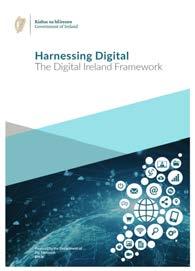

1. Source: Study on digitalisation on the manufacturing sector and the policy implications for Ireland (2018)
2. Source: Ireland's Industry 4.0 Strategy 2020-2025, 2019
3. Source: Harnessing Digital (Government of Ireland 2022), Harnessing Digital Progress Report (Government of Ireland 2023)


The manufacturing value add as a percentage of GDP for Ireland was more than double the EU average in 2022 (38% IRE; 15% EU) and has been more than double the EU average for almost a decade.
In 2023, 275,000 people worked in manufacturing in Ireland, representing 11% of total employment.*
The Irish Medtech sector specifically, consists of 350 companies employing 38,000 people making it the largest employer of Medtech professionals in Europe per capita and generates annual exports of €12.6 billion to over 100 countries globally.**
Our research team identified the MedTech sector to participate in this research study given the impact of technology on the changing nature of work within this vibrant sector.

350
38k companies people
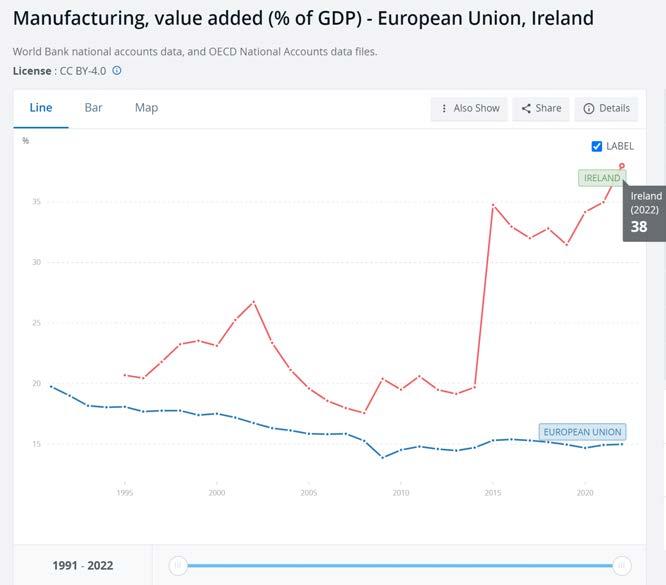
Sources: *IBEC, Manufacturing in Ireland 2023, https://www.ibec.ie/connect-and-learn/industries/ibec-networks/manufacturing-in-ireland **Enterprise Ireland https://irishadvantage.com/growth-irelands-medtech-sector/
Source: World Bank (latest available data)
https://data.worldbank.org/indicator/NV.IND.MANF.ZS?end=2022&locations= EU-IE





January
DMI partners with MIT and IAAE and invites participation from industry with a focus onhumancentric manufacturing (HCM) culture.
Engagement with DMI
March
The research team elicited key insights from leaders on the topic of HCM Culture in three different focus group sessions called Context,Challenges and Opportunities.
½ day at DMI
June
The research team held a call with site leads to:
- askquestionsabout this project roadmap
- share any further reflections
- identify specific insights your organisation would like to gain from participating
1 hour call
July-Aug
Surveys
A way of gathering insights and local context through a set of pre-definedquestions designed by our research team.
30 minutes per participant
Sep-Nov
Interviews with 3-4 groups ofkey leaders such as:digital transformation lead, site head, HR lead, and functional leads.
A day visit by our team but only ~1.5-2 hours per participant
November
An opportunity for the research team to ask clarifying questions after the in-person interviews and conduct additional interviewsif necessary.
~2 hours per participant
November
A presentation of aggregated key findings and discussion forum.
1.5 hour virtual meeting
November
An action-oriented workshop to illustrateinterventions and initiatives that organisations could adopt.
½ dayat DMI + short organisation 1:1


The HCM Culture Research Study was designed to include multiple points of engagement with, and interim feedback to, industry leaders over a one-year period.
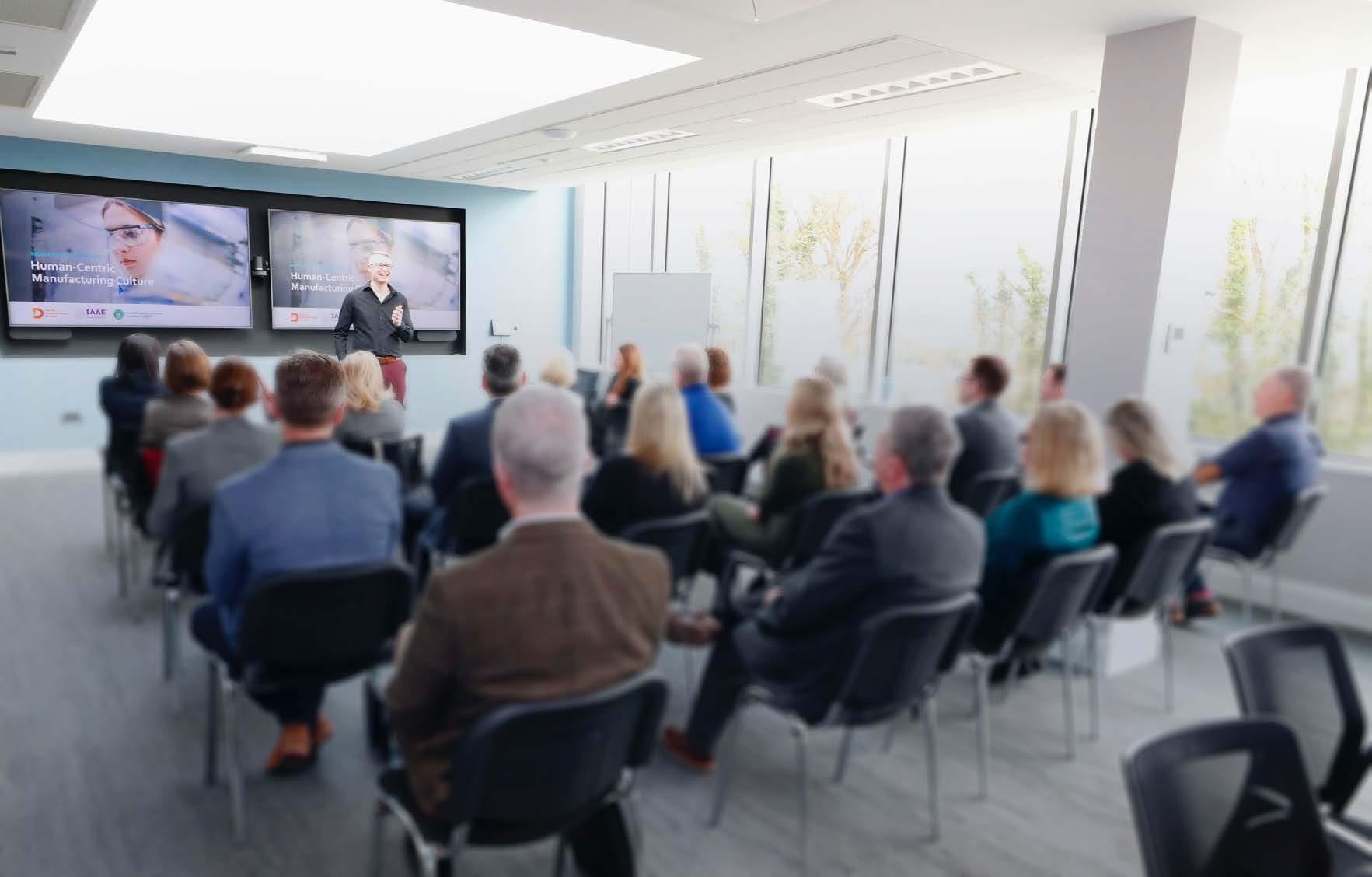

In March 2023, an industry focus group workshopwas conducted to elicit insights of leaders on HCM culture challenges, context and opportunities. Findings informed the detailed design of two research activities.
Further data was gathered using a survey that was completed by 89 leaders from 11 organisations.
Engineering/Business Excellence Lead Operations Lead Site Lead Quality Lead
Training/Learning & Development Lead
HR Lead Operations Supervisor
Other leaders Transformation Lead
Survey results were then used to design semi-structured group interviews. Thesein-depth site interviews were conducted with the leadership teams of 6 organisations represented by a total of 60 people.
Using expert knowledge, aggregated survey data and interview findings, 12 themes in 4 categories were derived. Literature and related studies were employed for an initial validation of findings.


Site-Related Challenges
1.Prioritising short term success over sustainable success
2. Giving space in design conversations for technology choices that are human-centric
3. Insufficient skills journey planning
Employee-Related Challenges
1. Untapped employee motivation due to lack of understanding of the benefits of HCM
2. Embedding good communications regarding how employees are valued during change
3. Fear of how digitalisation will affect jobs Study Survey Findings

The research team asked leaders to state how they perceive the majority of workers connect to the site where they work.
The findings confirm that matters of Safety and Health at Levels 1 and 2 are very well established.
This approach begins to reflect a whole-person paradigm within the setting of a workplace. As manufacturing organisations adopt a human-centric focus, the research team would anticipate even stronger agreement at Levels 3 through 5.
The team note however, that there may be significant variation in these findings if all personnel, and not just leaders, are surveyed.


"We believe human-centric manufacturing should ultimately address human needs defined in an Industrial Human Needs Pyramid –
needs of safety and health to the highest level of esteem and

from basic
self-actualization."
Source: Lu, Y. et al., Outlook on human-centric manufacturing towards Industry 5.0, Journal of Manufacturing Systems, Vol. 62, 2022
Level 5
Self-Actualisation
Self-fulfillment, leadership, personal growth
Level 4
Esteem
Achievement, respect, choice, meaningful, importance
Level 3
Appreciation, collaboration, involvement, share, care
Level 2
Physical health, cognitive health, psychological health
Level 1
Belonging Health Safety
Legal rights, protection, security


Leaders see the need to approach HCM as a culture change rather than a change initiative but lack understanding about how to operationalise this.
Multiple challenges exist relating to skill development and training (e.g., time pressure, generational differences, availability of training).
Organisations appear to be making progress in their efforts to increase cross-functional collaboration and openness in sharing knowledge.
Leaders are challenged to find time to focus on long term objectives and learning about latest digital manufacturing solutions and trends.
Digital dashboards are a ‘gamechanger’ for enabling open discussions and interacting with data in team-based decision making.




Our study used force field analysis to consider the driving forces for human-centric manufacturingculture and the restraining forces that push against this cultural transformation.
Irish government support for digital transformation (DMI, initiatives, other centers), and EU emphasis on Industry 5.0
Global organisation digital transformation strategies enable a strategic focus within Irish sites
Digital technology as enabler to more fulfilling roles
Irish “Clan Culture” natural fit for a human-centric organisation
Growing emphasis on communication and cross-functional collaboration
Data availability and digital dashboards make information more accessible and timely
Perception of HCM as a change initiative instead of a cultural transformation
Digital technology emphasis and expenditures may overshadow human-centric aspects
Insufficient time for leaders to understand digital technologies and formulating strategies
Competition for skills drives turnover in workforce
Generational factors drive diversity of worker needs and preferences
Digital technology can trigger fear of job loss
Training availability and scheduling options can be out of sync with worker availability Forces for





The research team synthesised the findings into 12 emergent themes grouped by 4 categories.

Imperatives
A strategic imperative is a business goal or objective that has the highest priority.
Values
Values are individual beliefs that motivate people to act one way or another.
Strategies
Strategies are methods to achieve goals.
Practices
Practices are actions that are repeatable and recognisable in a given cultural context.


Imperatives
Global Awareness, Local Innovation
Sustained Communication and Dialogue
Participative
Leadership and Decision Making
Values
Shared Mindset and Openness toward Change
Transparency, Trust and Open Knowledge Sharing
Respect for Knowledge and Tolerance for Failures
Strategies
Customer Centricity
Self-Directed Work Teams
Cross-Functional Alignment and Collaboration
Practices

Individualized Skill
Journey Planning and Role Crafting
Digitally-Informed Goal Setting and Assessment
Intrinsic and Extrinsic Rewards System


Global Awareness, Local Innovation

Sustained Communication and Dialogue
Participative Leadership and Decision Making



















manufacturing culture as providing the capacity innovation that is targeted to operational considering the global context of the and larger digital ecosystem. necessitates having global awareness of current emerging digital technologies and opportunities for local innovative approaches.











According to our survey, over 70% of leaders indicate they find value in contributing to wider industry through discussions and/or initiatives.
Leaders say:
We require a more strategic approach for HCM at all levels and for corporate wide initiatives from the top down.”
"We need to recognise that operators are the people who are in the best position to come up with new ideas” …people are not always aware of what’s coming with respect to digitalisation in manufacturing.”






Digital transformation impacts multiple aspects of an organisation, both technological and social. Sustained communication and dialogue at all levels of the organisation has been shown to have a positive benefit on workforce perception of change and on technology adoption.
Enabling technology such as digital dashboards contribute to communicating better information and act as boundary objects for meaningful proactive dialogue rather than simply reactive.


According to our survey, 67% of leaders strongly or moderately agree their organisation finds value in engaging in internal groups to discuss manufacturing transformation.
Leaders say:
Digital dashboards encourage open discussions and enable interaction with data.”
…we are linking changes that are being made to real-world (patient/customer) impact.”
"Our site leadership team has learned how to disagree during decision making yet how to agree on the final decision made."


Participative leadership is a leadership style for engaging a team-based, democratic approach to decision making. It empowers individuals to meaningfully participate in the decisions taken by leaders.
Engaging the workforce in decisions has positive



Fully


Our survey shows only 39% of leaders agree or strongly agree that fully engaging humans in decision making and operations is a valued HCM attribute.
Leaders say:
…about half of people are not included in decision making.” In some instances, there are issues with operators perceiving their opinions do not matter.” It would be very helpful if people had a better understanding of the reason for choices and how it would make their job better.”
This
According to the organisation leaders involved in this study:

A HCM culture provides the capacity for local innovation, that is both informed by, and influences, relevant global context.

Sustained dialogue and proactive communication at all levels of an organisation positively benefits the workforce perception of change and technology adoption.

Participative leadership is a leadership style for engaging with a team-based,democratic approach todecision making, and is known to have a positive influence on worker wellbeing.
Where organisations are doing well
• Leadership buy-in to digital transformation
• Global awareness and a clear vision
• Clear communications within organisation
• Open and honest communication
• Highly participative leadership
• Common forums for all employees
• Daily tier meetings
• Quarterly innovation awards
Where some have concerns
• Some global awareness but lack time to keep current
• Pushing decisions to the right level of leadership
• Knowing what every employee needs to be successful
• Breaking of barriers between different business units
• Conservative approach compared to sister sites
• Upskilling of leadership to lead digital transformation discussions

• Better understanding and communication of the value of digital technology
• Need better planning for preparing for future
• Need to improve clarity in sharing overall corporate vision
• Better understanding of what employees want in their work
• Authority for making decisions at the right level
• Some organisationsunderstand their need to deepen their culture of local innovation


A shared mindset means the members of an organisation share a common set of beliefs, values and goals.
One essential value in an HCM culture is openness toward change, and a shared belief that changes around digital technology (including industrial automation) are a means to both success of the organisation and for meaningfulness of work for individuals.
Leaders create the conditions for shared mindset to emerge through their actions and behaviour.
"We need to develop a technology adoption approach where people see automation as a means to retain market share and remain competitive rather than a threat.”





Some leaders in our study see an opportunity to better communicate the organisation’s history of how previous automation was introduced and its positive impacts to workforce and the business.
Leaders say:
….there is a need for a mindset shift to embrace change.” There is strong agreement on need for more communication around cycle of change.”
… an opportunity to reflect on building capacity for change instead of resisting/postponing change.”




Respect for knowledge is a key attribute of HCM culture, evidenced by human knowledge being held in high regard, including both individual knowledge and organisation-level knowledge. Knowledge should be recognised as always evolving over time and organisational knowledge viewed as being greater than the sum of knowledge possessed by individuals.
Tolerance for failure is important for generating new learnings and advancing existing knowledge. Leaders in HCM culture foster appropriate levels of risk-taking by individuals and teams. They establish both the atmosphere and structures for knowledge sharing arising from such risk-taking in their organisations. Placing experienced people in with teams to work alongside and assist newer team members with problems is beneficial and helps to reduce downtime.”

Our survey shows 50% of leaders agree or strongly agree their site tolerates and learns from failure in digital initiatives; however, 20% are neutral or disagree.
Leaders say:
…everyone is allowed to question and challenge things.” We encourage learning from mistakes and failures" ….during onboarding we could do more to comprehensively understand and capture knowledge that new employees bring.”


Transparency, trust and open knowledge sharing are interrelated attributes. Open knowledge sharing can be thought of as an organisational principle that is used in setting policy and practices, including what is shared and who has access to information.
Transparency is a capability perceived by individuals and can be enabled through technology and organisational policies. Trust is a quality perceived by individuals that can be influenced by transparency and open knowledge sharing.
Organisational trust is an emergent quality based on individual perceptions and organisational behaviours and is a uniquely human requirement for effective collaboration and performance.
"We respect each other and our business partners by being open to different ideas and perspectives and being appreciative of each person's contributions.”




About 75% of leaders strongly or moderately agreed that there is open knowledge sharing between people and functions at the site.
Leaders say:
Giving people visibility and clearly communicating changes will reduce fear or nervousness that they will lose their jobs.”
Communication is coming down, but it is filtered information not the whole information.”
We could better engage multiple levels of the workforce by better communicating upcoming changes.”

A shared mindset means the members of an organisation share a common set of beliefs, values and goals. A shared mindset is a key enabler of openness toward change.

Transparency, trust and open knowledge sharing are interrelated attributes. Organisational trust is a uniquely human requirement for effective collaboration and performance.

Leaders in HCM culture foster appropriate levels of risk-taking by individuals and teams and promote the value of both individual and organisational-level knowledge.
According to the organisation leaders involved in this study:
Where organisations are doing well
• Culture of trust and openness to change
• See increased cross-functional collaboration
• Culture of open knowledge sharing and helping each other
• Leaders are committed to change and promote shared vision
• Shared mindset around importance of customerconnection
• Values and goals are patient-centric
• A strong sense of mission

• Organisational structure can be a challenge to open mindset
• Self-directed teams assessing operational resources early
• Some closed thinking at corporate levels
• Trust is linked to tenure and evidence
• Tolerance for failure is time sensitive
• Adapting to a self-directed culture
• Need for time to innovate, test/trial/pilot
• Need to improve self-linked teams
• Making everyone in the organisation aware of what we do
• Creating processes that are more human-centric

Customer Centricity
Self-Directed Work Teams

Cross-Functional Alignment and Collaboration


Customer centricity is a strategy using ‘customer thinking’ to align the organisation products/services with wants and needs of its most valuable customers.
Customer centricity provides the ability for people in the organisation to better understand the customer’s situation, expectations and perceptions. It places the customer at the centre of all decisions.
Where workers are not in direct or frequent contact with customers, it has been shown that customer narratives and stories are highly motivating and insightful.
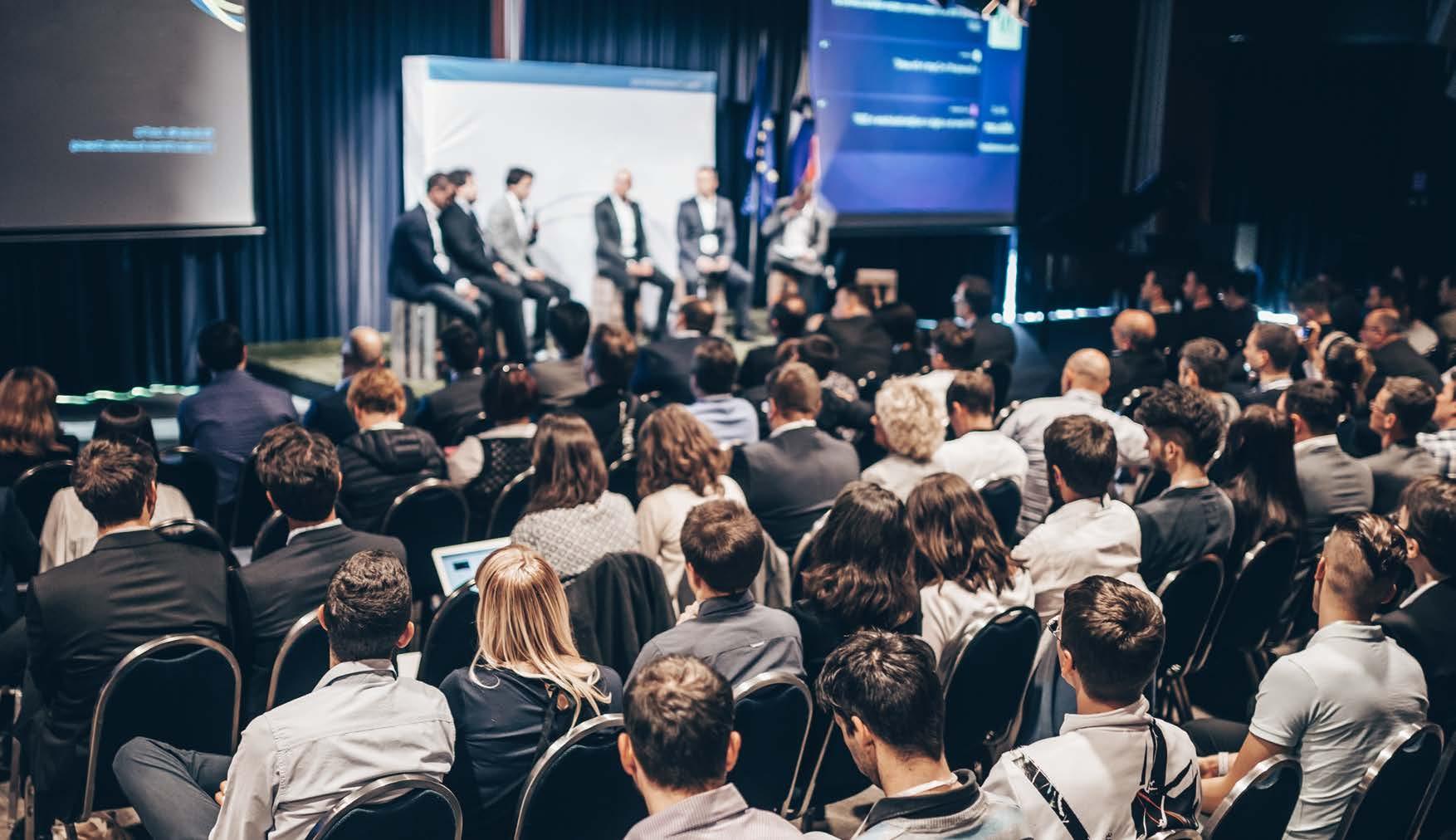




Interviews showed evidence that organisations are highly customer focused and customer centric, and rapidly respond to new customers.
The research team observed strong evidence of the ways that sharing patient stories and showing realworld impact of products is embedded in the culture.
Leaders say:
"Our customers are on site and directly engage with leadership and operators.”
"People are motivated by hearing stories of impact on lives.”




share managerial and operational responsibilities, driven by a shared set of goals. These teams have been observed to have more accountability for success and to be more innovative. Such teams are comprised of people with diverse abilities that discover effective ways of working and making decisions as a group, owning challenges and problems, rather than simply acting on tasks.
Self-directed teams enable leaders to focus on strategy more than oversight. Leaders better enable such teams by creating the conditions and environment for success.

Next to technological innovation, social innovation is also a top priority, thereby focusing on personal involvement, creativity and autonomy of teams and individual employees. Factories of the future not only work faster, but smarter.
https://commission.europa.eu /




Our interviews indicate many organisations are encouraging more self-directed work teams. Digital technology and availability of data are enablers for self-directed efforts.
Leaders say:
We have an opportunity to equip operators to be able to take ideas to the next step.”
We could better empower the production group leaders”
… enhancing the role of product group leaders is key to self-directed work teams.”

Having production assistance support could help alleviate paper-intensive and time demanding tasks , freeing up line leads”



Cross-functional alignment and collaboration results when individual functions or teams work together on a common project with a set of established goals.
Leaders encourage cross-functional collaboration by setting clear goals and providing supports for efficient and effective team interaction.
Cross-functional collaboration has been shown to be more evident in digitally advanced organisations.


Our survey indicates two-thirds of leaders moderately or strongly agree that cross-functional leadership decision making at the site happens effectively, while one third disagreed or mildly agreed.
Leaders say:
… there is much more collaboration now – we used to compete against each other much more.” Rapid growth can sometimes cause disconnects with new people.”
We could do more collaboration in early stages and use steering meetings more effectively.”
According to the organisation leaders involved in this study:

Customer centricity is a strategy using ‘customer thinking’ to align the organisation products and services with the wants and needs of its customers. Effective sharing of customer stories is highly motivating and insightful.

Self-directed teams share both managerial and operational responsibilities rather than only tasks and are driven by shared set of goals. These teams provide the benefit of bringing together people with diverse backgrounds and abilities.

Cross-functional alignment and collaboration results when individual functions and teams serve each other through effective interdependent alignment within a set of established objectives or goals.
Where organisations are doing well
• Customer centric strategy
• Strong awareness of customers
• Active customer feedback
• Have customer based KPIs
• Good flows to deploy strategies
• Strong cross-functional alignment
• Use of storytelling and patient first
• Aligning at management levels to minimise silos
• Onsite customers have transparency into data and operations
• Some concerns on tolerance for failure at the team level
• How to maintain open knowledge sharing as business scales
• Organisational structure not fit for purpose

• Achieving a blame-free culture
• Promoting failure as a part of rapid innovation
• Strategies that better support personal growth
• Setting targets that are more possible to achieve
• Organisational structure makes crossfunctional alignment difficult


Individualised Skill Journey
Planning and Role Crafting
Digitally-Informed Goal
Setting and Assessment
Intrinsic and Extrinsic Rewards System
Individualised skill journey planning and role crafting relates to an organisational practice that embraces a perspective that skills, knowledge and abilities are evolved over time. It recognises that roles will shift as digital technology influences the human-technology roles and interactions.
A more fulfilling skills journey will result when people can co-create a personalised skills plan and help to create a unique role for themselves. This activity considers the individual’s known and emergent training needs, their desire to learn new skills, and their personal career goals.





According to our survey 50% of leaders see insufficient skills journey planning as a challenge that may prevent HCM
Leaders say:
"There is an opportunity to better illustrate career journeys”
"There is a strong opportunity for a skills identification workshop and then upskilling”
"We see an opportunity to identify and track skills and skill gaps.”

Digitally-Informed Goal Setting and Assessment relates to a practice where goals are established and assessed based on human knowledge and insights, as enabled by data. The available data, information and trends are generated through the power of digital technology.
Digital dashboards for example, provide a portal for workforce and customers to not only have access to actionable information and data, but have this data come to the right person, at the right level, at an optimum frequency for proactive purposes.
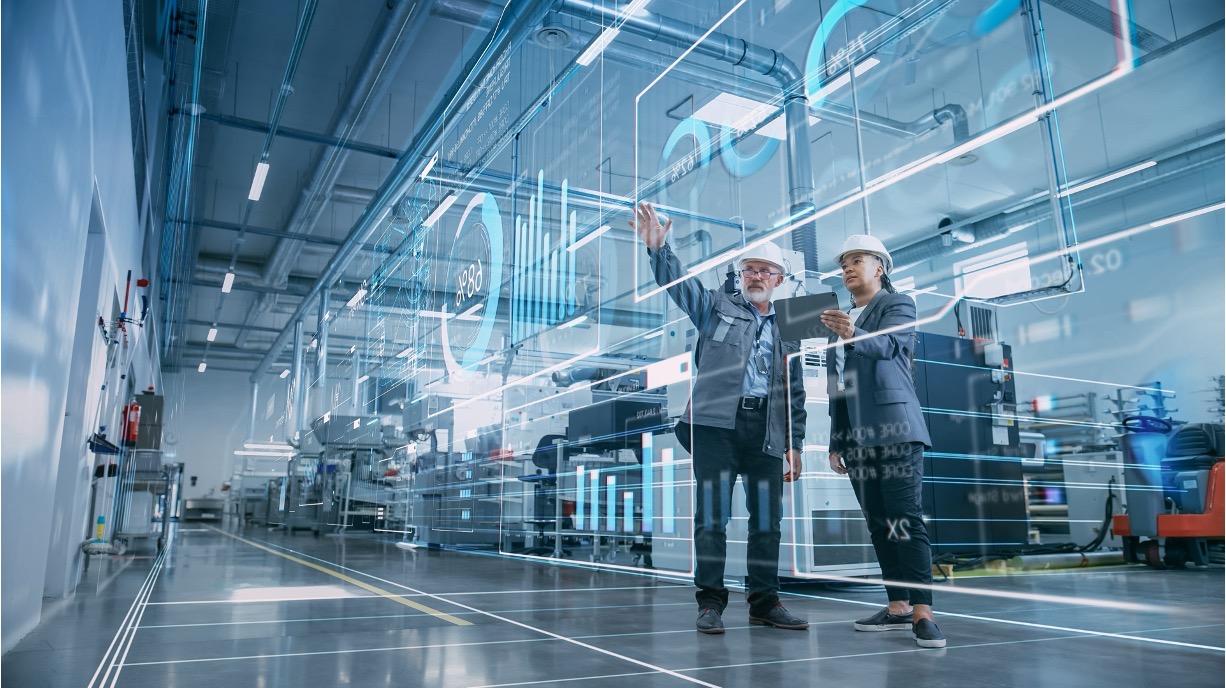


Site leaders indicated they have strong year-to-year plans, but insufficient focus on long-term goals that better use data analytics for goal setting and evidence-based decisions .
Leaders say:
Information is not analysed enough and lessons learned are not assessed.”
There needs to be a better balance of meeting monthly numbers and doing sustainable improvements”
We want to improve information dashboards within buildings so they do not motivate wrong behaviours.”


An intrinsic and extrinsic rewards system considers the diversity of motivation.
Extrinsic rewards are tangible pay, bonuses, and benefits. Intrinsic rewards are psychological benefits that each employee gains from making meaningful contributions to their work and delivery of value to customers and end-users.
The value of intrinsic benefits is perceived by the recipient of the reward, and it has been observed that there are generational differences in what types of intrinsic rewards might be desired.
The rewards system needs to effectively align with a human-centric manufacturing culture.

More than 25% of leaders indicate that an employee-related challenge is that employee incentives are not aligned with HCM initiatives.
Leaders say:
It is important to recognise and show appreciation for employees … it should be continuous, not just tied to hitting targets.”
Recognition awards/vouchers could be better defined and used, and made more suitable for signifying appreciation.”
We should consider how to introduce more variability in roles and tasks to increase the likelihood that employees see their contributions as valued.”

According to the organisation leaders involved in this study:

A more fulfilling skills journey will result when people can co-create a personalised skills plan that considers the individual’s known and emergent learning & development needs, desire to learn new skills, and personal career goals.

A practice where goals are established and assessed based on human knowledge and insights, as enabled by data. Thoughtful digital technology investments can enable data to come to the right person, at the right level, and at an optimum frequency for proactive purposes.

Extrinsic rewards are tangible pay, bonuses, and benefits. Intrinsic rewards are psychological benefits that each employee gains from making meaningful contributions to their work and delivery of value to customers and end-users. Both are essential in an HCM culture.
Where organisations are doing well
Where improvement is needed
• Leadership engaged in team-based approach
• Micro learning
• Tier boards with clear goals
• Individual Development Plans
• Investing in career planning
• Reward structures
• Internal promotions and hiring from within
• Good extrinsic rewards

• Reward system not fully aligned with HCM
• Being ‘data rich’ but ‘knowledge poor’
• Individual skill planning not done for every person
• How to reward people for open knowledge sharing
• Need for upskilling for all systems that are in place
• Need to have operators design dashboards
• Better data-informed goal setting
• Joined up approach to skill planning
• Time to learn and experiment
• Need more shared learning on failures/successes
• Visualising the right information when and where needed
• Open forums for how people can improve their environment through digitalisation

Background. The Competing Value Framework, created in 1983 by Quinn and Rohrbaugh, continues to be one of the most important frameworks for characterising and understanding organisational culture and leadership. In recent years, the framework has been used in many papers in context of digital transformation and digitalisation. The framework classifies four cultures: Hierarchy, Market, Adhocracy, and Clan.
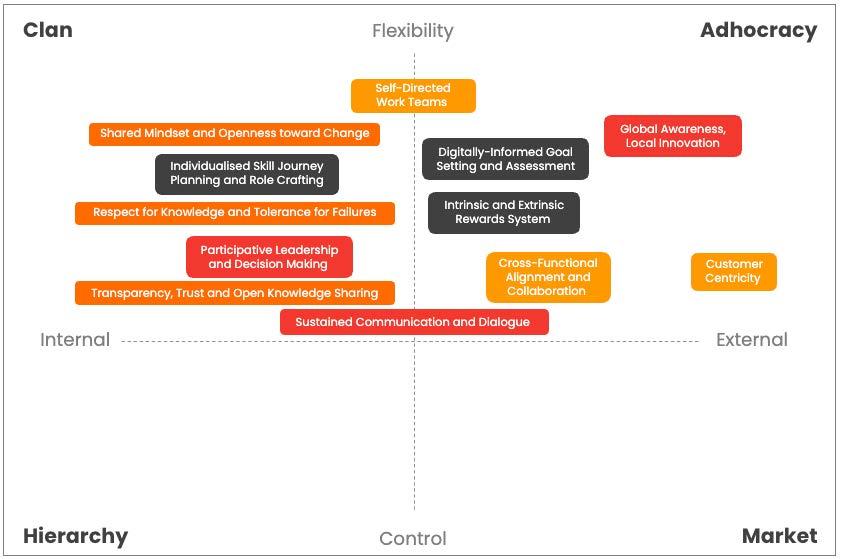
Consistent with what we have seen in other studies, we see Clan and Adhocracy as the quadrants that are most relevant for digital transformation.
Clan culture is the people-oriented culture that emphasises collaboration. Adhocracy is the more informal, entrepreneurial culture.
Observations. We found it interesting to consider the twelve themes that emerged from this study against the quadrants, and colour coded by our theme categories of imperatives, values, strategies and practices. Our initial attempt at mapping illustrates our twelve emergent themes are in the Clan and Adhocracy quadrants. This is consistent with some other studies that did similar mapping. We see many of our themes mapping to Clan culture. It is interesting to note that we observe Irish manufacturers to have an advantage given the well-acknowledged presence of Clan culture in Ireland. We also note the direction many of the Irish manufacturers who engaged in this research are seeking to move toward more self-directed teams and innovation, which fits in the adhocracy quadrant.It was interesting to observe during our site visits to six of the participating companies that no one company has strengths in all of these areas. However, we are confident in saying that each company did have several key strengths and that how these companies developed and maintain these strengths will be of interest to others.
Future Work. An area of future work is to investigate how different companies map the themes, and where they see they are strong and where they are interested in improving. We believe the framework will be an enabler to cross-company dialogue.




– Competing Values Framework
Adapted by IAAE, MIT, and DMI for the 2023 HCM Culture Study
This framework provides a visual tool for organisations to have further discussion on how to think about each of the twelve themes as they relate to either 'Clan' or 'Adhocracy' quadrants.
Imperatives
Values
Strategies
Self-Directed Work Teams
Shared Mindset and Openness toward Change
Individualised Skill Journey Planning and Role Crafting
Respect for Knowledge and Tolerance for Failures
Participative Leadership and Decision Making
Transparency, Trust and Open Knowledge Sharing
Internal
Global Awareness, Local Innovation
Digitally-Informed Goal Setting and Assessment
Intrinsic and Extrinsic Rewards System
Cross-Functional Alignment and Collaboration
Sustained Communication and Dialogue
Customer Centricity
External
Practices
Note that the placement of the themes are notional and are for further discussion in a specific context.



how a collaborative approach is driving Ireland from 5.0 states:
challenges... Around the world, most manufacturers are challenges with a tight-knit group of partners and consultants, the potential of Industry 5.0 is a larger group effort.
government bodies and academic institutions are all working proving fruitful, with some projects even being held up
a byproduct of operating in Ireland. The country has a density of manufacturers that have developed into activity in a relatively small geographic footprint. This organisations to collaborate and partner.
Irish government proactively works with manufacturers digital, disruptive and sustainable technologies through

The study participants were strongly in favour of continuing the dialogue and collaborating with peers to address areas identified requiring action. The following areas were prioritised during a November 2023 workshop to be addressed as part of the HCM Centre of Excellence in 2024.

Defining aspects of a HCM culture mindset and illustrating these by developing HCM culture best practices within Irish industry by both themes and roles (e.g. Frontline worker, Staff engineer, etc.). Share strategies for successfully implementing HCM.

Defining supporting behaviours and competencies, and how best to develop and adopt them, goingbeyond technical skilling, so leaders can foster within a workforce a stronger pull, instead of pushdynamic for technological innovationandadoption.

Identifying HCM related learning (skills through education and training) anddevelopment (competencies through coaching, mentoring and other means) and ways to pilot and scale.

Connecting the purpose of digital transformation to the front line –‘what's in it for me’. Defining what this enhanced role will look like in various HCM contexts, new competency expectations and related behaviours, and new supports that will be needed.

Characterizing self-directed work teams in context of humancentric manufacturing, as well as sharing successful practices with participating organisations. This is a key area for collaboration going forward.
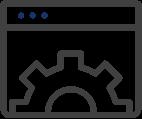
Collaborating to inform the better design of digital dashboards through HCM principles leading to better decisions (with an emphasis on predictive over reactive) being made at the right level of the organisation, and fostering a data-driven culture.

Working together to agree on industry working definitions for HCM, and HCM Culture, as well as value proposition and ROI talking points forboth the organization workforce and global leader peers.

The research team suggest organisations could use a guided process to go from a theme (e.g., self-directed work teams) to design an intervention that fits the specific needs, situation, and culture of their organisation. Following this, an implementation roadmap can be developed.
What aredigital transformation intervention strategies?
Intervention strategies encompass approaches, methods, initiatives, and techniquesthat are intended to shift the enterprise in a positive direction toward achieving its digitalisation vision.
Interventions must be suited tothe culture and mission of the site, thetime scale of thetransformation, and responsive tothe current state of the organisation.
In designingan intervention,itis essential to consider preconditions and constraints, barriers to change, root causes,context factors, stakeholder preferences,and existing site capabilities.
Considering these aspectsand the unique culture of the site, it will be necessary to determine specific change mechanisms, change agents,and change pathways.
Effectiveness andadoption of interventions will then need to be monitored andadaptedas needed.




• The twelve emergent themes providegeneral concepts that can be made specific for an organisation.
• A plannedarea of futurework is to develop a guidingprocessand oneor more patterns for each theme.
• A pattern is a generalised implementation description that captures best available knowledge respective to a theme (e.g., customercentricity).
• Site leaders can use a patternas a template for designing a site-specific intervention strategy that suits the organisation’sunique situation, culture, resources and needs.


What new thinking is needed by leaders?
What should leaders do differently?
What about Ireland's culture gives a HCM advantage?
Re-invigorate your leadership philosophy and practices with a whole-person view of work and workers, with appropriate inclusion in decision-making at strategic, tactical, and operational levels.
Carefully identify how to retain and strengthen the best of your existing culture, and how to use evidence-based approaches to do so.
Reflect more proactively on the cultural impact to your organisation that stems from digital manufacturing choices and bring a focus to creating organisational capacity forchange.
Consider how to be more empathetic of operation and technical staff's daily frustrations of legacy processes, both for physical and information flows.
Assess how to design intrinsic rewards that your organisation could offer to better leverage attracting or keeping talent.
Deepen your understanding of the opportunities, benefits, and crucially, potential unintended consequences of Industry 4.0 technologies and automation.
Renew your thinking as to how you are using the skills that already exist in your organisation, as well as the new skills and roles that need to be developed at every level.


Use digital technology/data to better empower self-directed teams and equip product group leads with suitable information at the right time.
Identify industry collaboration opportunities relating to human-centric manufacturing to both learn about and contribute to best practices.
Consider an internal forum for your leaders to have an opportunity for open discussion about HCM and tangible ways to include new thinking.
Elevate workforce well-beingas a key criteria for digital transformation investment.
Ensure multidisciplinary teams are involved in design and testing of digital dashboards that display leading indicators, motivate the right behaviours, and make problems visible early to facilitate fast problem solving.
Take steps to enhance your own understanding of systems thinking, organisational change management, design thinking, and human performance, - each will add a key dimension to your thinking as a leader.
Push tolerance for failure philosophy into the team level so it becomes included in team norms with an opportunity to innovate in sandbox environments.


The following quotes illustrate some of cultural traits that the research team observed during discussions with leaders beyond the planned study findings as indicative of the strong clan or 'Meitheal' culture that Ireland is well known for.
Can-do attitude
"We are a very can-do organisation, get it done, do whatever it takes. It's incredible the attitude around here."
Taking Initiative
"We are always looking at what we can do better."
Leaders want toempower others
"We want to empower them to make good decisions … at any time."
Taking time to enjoy a good laugh
"You need it, we need to have humour. Joke Friday."
Humility and respect for others
"No senior leader here has any pompous about them- they are workers like everyone else. Senior leaders know all names, most names- call them by their name and meet them....and let them know the importance of their work. "
An overwhelming 93% of participants in this study survey agreed or strongly agreed that managers and leaders at their site show care and consideration to those who report to them, for example whenemployees are supporting a family member during a season of illness.
- Human-Centric Manufacturing Culture Study, DMI, MIT, and IAAE, 2023
Notably, 87% of participants in this study survey agreed or strongly agreed that, at the end of their career, they would attend a reunion with the people they work with today.
- Human-Centric Manufacturing Culture Study, DMI, MIT, and IAAE, 2023


Sara Cuddy Director, People, Skills and Culture Transformation
HCM is a Culture Transformation, aligning enterprise strategy, leadership values, and technology to enable a data-driven, peoplecentered organisation.

Donna Rhodes Principal Research Scientist, MIT

Malcolm Jeffers
Head of Research, IAAE
Our study shows why reorientation toward humancentric culture over technology is vital to the future of digital manufacturing.
As the novelist Victor Hugo once said, "There is nothing so powerful as an idea whose time has come." Human-centric manufacturing is a paradigm shift whose time has come.


Most recently, a 2024 report by IDA Ireland and Skillnet Ireland, included a section that covered the role of culture in skills development. The points reproduced on the rightresonate with the themes identifiedin the findings section of this study.
Kiernan, C., (2023) How a collaborative approach is driving Ireland from Industry 4.0 to Industry 5.0, Control Engineering
Lu, Y., et al. (2022).Outlook on humancentric manufacturing towards Industry 5.0. Journal of Manufacturing Systems. Volume 62
Hartl, E., & Hess, T. (2017). The role of cultural values for digital transformation: Insights from a Delphi study. Twenty-third Americas Conference on Information Systems
A common thread across focus group discussions was that culture was seenas critical to skill development and digital transformation. Below are some of the main findings:

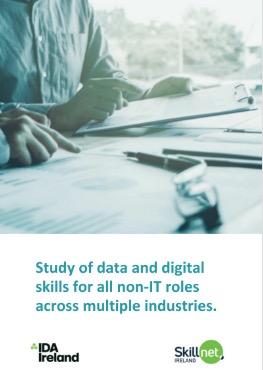
• Creating a culture of continuous learning and upskilling empowers and encourages experienced employees and new joiners to develop core skills.
• “Buy-in” is critical: When people understand the reasons for digitisation and have an answer to the question of “what’s in it for me?” they are more likely to want to develop data and digital skills.
• In organisations where leaders proactively address common reasons for resistance (such as fear of new technology), there was more employee engagement with data and digital skills and tools. Such organisations had leaders who drove a culture that empowered people through change.
Source:

IDA Ireland and Skillnet Ireland, 2024, Study of data and digital skills for all non-IT roles across multiple industries
Government of Ireland 2023, Harnessing Digital - The Digital Ireland Framework 2023 Progress Report
European Commission, Directorate-General for Research and Innovation, Dixson-Declève, et al., 2023, Industry 5.0 and the future of work – Making Europe the centre of gravity for future good-quality jobs, Publications Office of the European Union, https://data.europa.eu/doi/10.2777/685878
Irish Dept. of Business, Enterprise, and Innovation, 2019, Ireland’s Industry 4.0 Strategy 2020-2025 -Supporting the digital transformation of the manufacturing sector and its supply chain
Manufacturing Institute USAMxD, IAAE, MIT, HCG, 2022, Capacity and Mobilization Assessment of the Pharmaceutical Industry Utilizing Technologies to Optimize/Scale-Up Production
European Commission, 2021, Industry 5.0 Towards a sustainable, human-centric and resilient European industry
University of Cambridge, 2018, Study on digitalisation of the manufacturing sector and the policy implications for Ireland

This whitepaper was written in early 2023 by the authors to inform and assist in framing the approach for this study.
Human-Centric Manufacturing Culture Study - Whitepaper
MIT Sociotechnical Systems Research Center
https://mit.edu
International Academy of Automation Engineering
https://myiaae.org/
